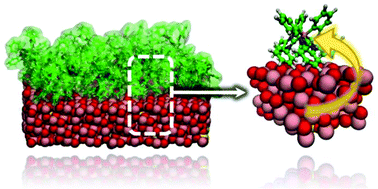Nanoscale morphology and electronic coupling at the interface between indium tin oxide and organic molecular materials†
Abstract
The correlation between nanoscale morphology and charge injection rates at the interface between an organic semiconductor layer and a transparent metal oxide electrode was investigated by integrating molecular dynamics simulations with electronic structure calculations. The simulation approach proposed has been applied to the analysis of the hole injection mechanism at the interface between an amorphous layer of tris[(3-phenyl-1H-benzimidazol-1-yl-2(3H)-ylidene)-1,2-phenylene]Ir (DPBIC), a hole transport and emitter molecule, and the surface of indium tin oxide (ITO), a material commonly used as anode in OLEDs. The link between interface morphology and charge injection was investigated by implementing a two-step, top-down simulation approach. Namely, nanoscale molecular aggregation phenomena at the organic/electrode interface were first assessed by molecular dynamics simulations, mimicking different processing conditions, and followed by density functional theory calculations of the electronic coupling between molecular levels and the manifold of electrode states involved in the charge injection process. The correlation between structural parameters and electronic coupling suggests a significant role of specific molecule/electrode configurations on charge transport processes at the interface, resulting in a broad distribution of charge injection rates, and highlights the link between molecular structure, nanoscale aggregation and processing in the realization of heterointerfaces for efficient charge injection in organic electronic devices.



 Please wait while we load your content...
Please wait while we load your content...